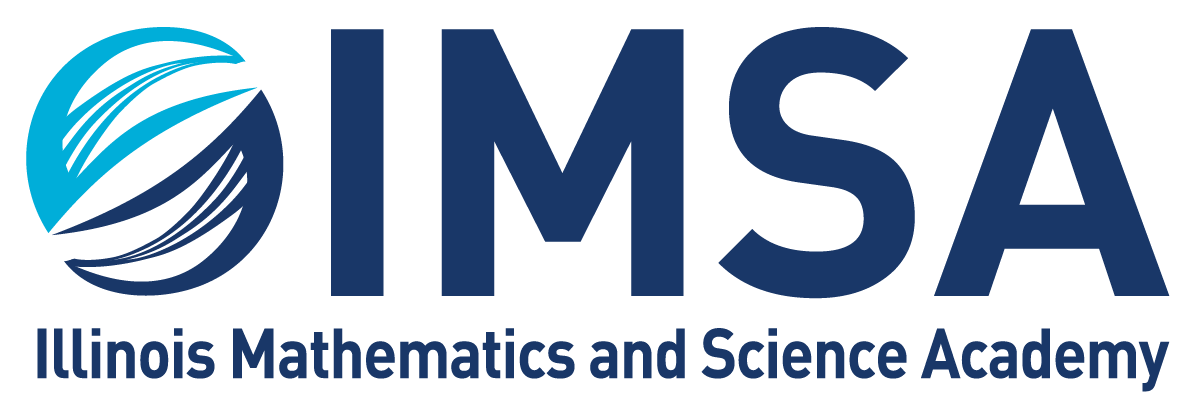
Illinois Math and Science Academy’s “Equity and Excellence” plan seeks to make equity part of “every facet of the Academy”
Incidents
On March 21, 2018, the Board of Trustees adopted its “Equity and Excellence” policy, which states that the model is “the intentional integration of Cultural Competence, Diversity, Equity, Equity-Minded Frame, Excellence and Inclusion into every facet of the Academy.” The continues with “the understanding that it is an active and ongoing process involving structures, processes and people and not an isolated initiative.”
In the model policy, the board defines “diversity” as “Individual differences (e.g. personality, learning styles, and life experiences)” and “group/social differences (e.g. race/ethnicity, gender, sexual orientation, gender identity or expression, country of origin, and ability as well as cultural, political, religious, or other affiliations) that can be engaged in the service of teaching, learning and advancing the human condition.” The definition concludes with the addition that it “includes tracking the numerical and proportional representation of various racial and ethnic groups among students and employees.”
The board defines “equity” as allowing access for “Culturally, Linguistically and Economically Diverse and Marginalized students” to “differentiated academic and social-emotional supports and interventions” with the intent of creating an “opportunity for them to participate in educational programs and co-curricular activities that are capable of closing the excellence gaps in student experiences, success and retention.” In regard to the schools “workforce,” the board states that equity means “differentiated strategies and resources to attract, retain and professionally develop Culturally, Linguistically and Economically Diverse and Marginalized applicants and employees.”
The policy clarifies that “marginalized” groups are those who “traditionally lack access to rights, resources, and opportunities, and are often socially excluded, including, but not limited to, LGBTQIA+, undocumented, female, and twice-exceptional.”
The “Equity and Excellence” model states that the Academy “shall pursue” this policy by “developing and using an equity lens when considering major policies, programs, practices, or decisions in order to realize more equitable outcomes,” providing staff with professional learning that “continuously develops the Cultural Competence and equity awareness” and by differentiating resources “as necessary to provide every student with access to Culturally Competent pedagogy, curriculum, co-curriculum, support, facilities and other educational resources with an ultimate goal of achieving Excellence.”
As a result of the board policy, the Academy produced “IMSA’s Equity and Excellence Plan Development Theory of Change Executive Summary.” The plan was later approved as “an official research study by the Institutional Review Board.” The defined purpose of the study is “to develop an equity and excellence plan that is driven by the IMSA Board Approved Equity and Excellence Policy, rooted in Theory of Change, informed by data, and facilitated through an inclusive, equity-minded frame.”
The document states that “the most distinctive characteristic of Theory of Change in contrast to other methods is that it focuses first on outcomes, rather than interventions.”
Stating that “diversity, equity and inclusion trend is evident on the global level,” the plan lays out that the Academy has “adopted the United Nations Sustainable Development Goals” citing from Sustainable Development Goal 4 which is to “‘ensure inclusive and equitable quality education, and promote lifelong learning opportunities for all’.”
The Academy also utilizes the Danielson Framework, which “has diversity and equity at the heart of it.”
The STEM school has partnered with Midwest and Plains Equity Assistance Center to help implement the development plan. Also, in the Nov. 20, 2019, “Report of the President,” it conveys that the Academy is “providing professional development” through a “new book club” that is reading controversial author Robin DiAngelo’s White Fragility: Why It’s So Hard for White People to Talk About Racism.
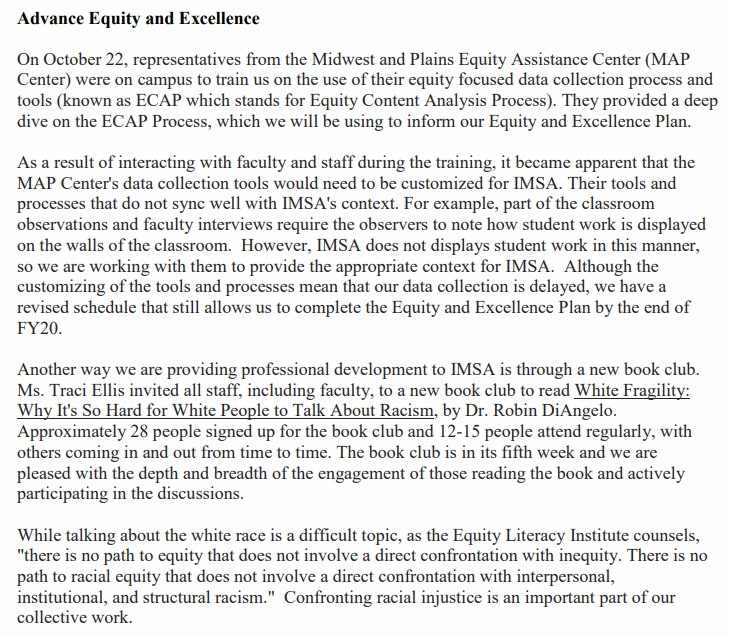
On March 8, 2022, the Academy’s Director of Equity and Inclusion, Adrienne Coleman, gave a webinar titled “Empowering Educators to Lead the Change for Equity and Excellence.” The presentation includes slides such as “Privilege and Oppression” and “Courageous Conversations” (a core programming from the consultant Pacific Educational Group LLC.).
A slide from the March presentation titled “Racial Identity Conflict” states that “Acting White” is when “Black and Latinx Students tend to deny or hide their talent and potential in order to not being seen or viewed as smart or valuing academic achievement.” It defines “Cool Pose” as “A defense mechanism and ritualized form of masculinity that allow them to cope with oppression, racism and oppression.”
The presentation concludes with a slide titled “Leading for Equity and Excellence,” which highlights the stages of equity as defined by equity consultant Equity in the Center. The stages include “Awake” which focuses on the demographic makeup of a school, “Woke” which focuses on the culture and environment, and “Work” which “systems to improve educational equity.” The “Work” stage also involves “internal and external systems change and regularly administering an educational equity assessment to evaluate processes, programs, and operations.”
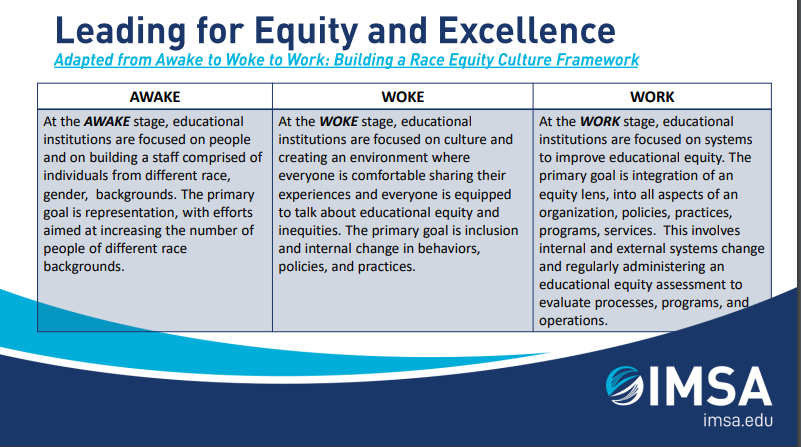
A May 1, 2020, publication from the Director of Diversity, Equity, and Inclusion titled “Examining the Racial Implications of COVID-19 through Courageous Conversations” was released to the Academy writ large. Per the abstract, the Director states that “Our students are having to confront Microaggressions that some have never experienced before” and “when I talk about microaggressions, I’m talking about verbal, behavioural, or environmental indignities, whether intentional or unintentional, that communicate hostile, derogatory, or negative prejudicial slights and insults toward any group, particularly culturally marginalized groups.”
In the Director’s slide presentation, the third slide states “Why are Black People Dying at Higher Rates from COVID-19?” The answer listed below the question is one word, “RACISM.”
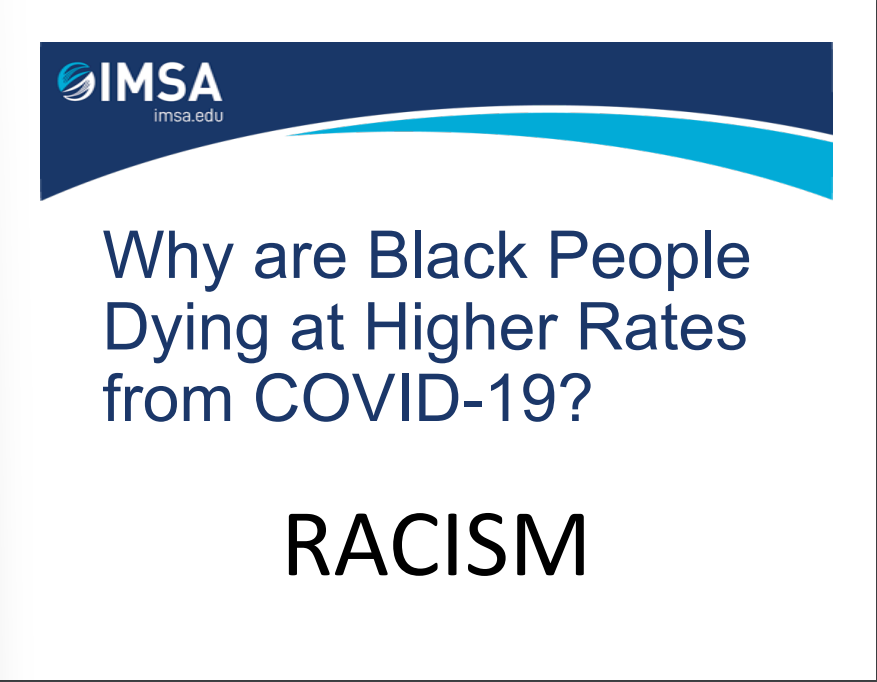
The fourth slide states “Why are Latinos Being Hospitalized for Coronavirus up to Three Times the Rate of White Americans?” “Undocumented and DACA Status Racism.”
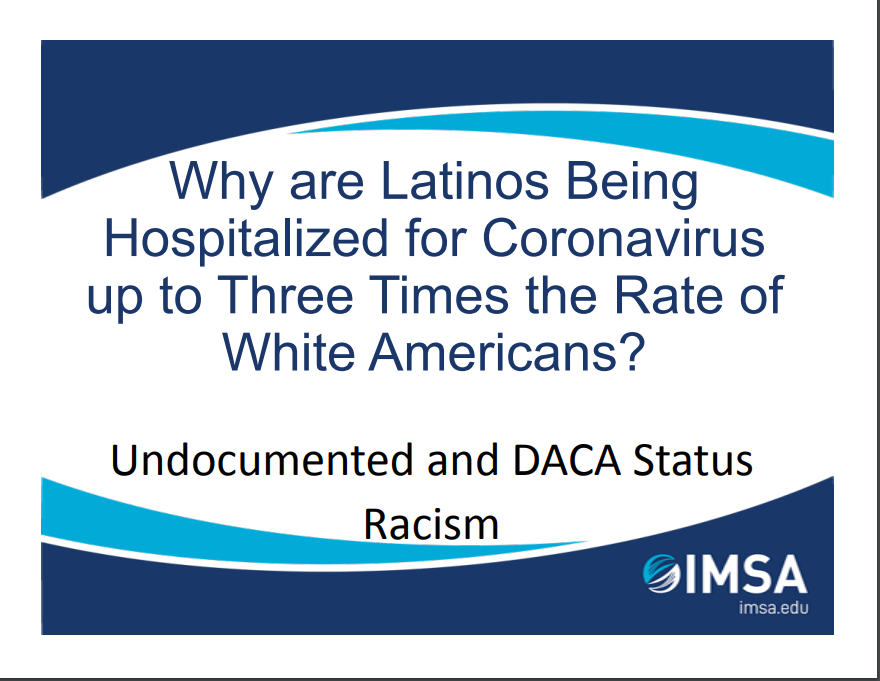
In addition, the Director put out a supplemental statement outlining the Academy’s “response to COVID-19 and remote teaching and learning through that lens.” The document states that several issues including “racism, classism, and oppression have come to light since this pandemic has hit.” It continues by highlighting that there has been “an increase in Xenophobia” and “harassment” towards “Chinese, Chinese Americans (sic), and other Asian groups.”
The statement goes on to add that students “are having to confront Microaggressions that some have never experienced before” and that what the director is referring to when talking about microaggressions includes “verbal, behavioural, or environmental indignities, whether intentional or unintentional, that communicate hostile, derogatory, or negative prejudicial slights and insults toward any group, particularly culturally marginalized groups.” The paragraph ends with “Xenophobia is spreading just like this virus.”
The following paragraph of the statement states that the Academy will assist students with “confronting microaggressions” and dealing with the “increased number of deaths” from the community by “having virtual Courageous Conversations! Utilizing Glenn Singleton’s four agreements.”
The Academy also posed a challenge to students titled “How to disrupt systemic racism in Black and Latino Communities that have caused underlying factors such as health disparities and economic inequities, contributing to higher incidence of coronavirus in their communities?” The challenge requires students to attend a “Virtual Courageous Conversation featuring a panel of STEM experts discussing the implications of COVID-19 from racial and economic perspectives.”
The students will then need to develop an “innovative idea” that addresses the problem. Then, students are to answer the question “How does this idea reflect upon, acknowledge, challenge and disrupt systemic racism, discrimination and oppression that have contributed to the ‘status quo’?” The statement tells the students that the “7 most innovative ideas” will be awarded cash prizes.
In 2019, the Director posted to the Academy’s Diversity, Equity, and Inclusion Student Programming page the document “I’m Not Racist, Am I? Facilitator guide.” The facilitator guide is complimentary to the documentary “I’m Not Racist…Am I?”
The film, a documentary “about how the next generation will confront racism,” follows “12 teenagers from New York City for one school year as they come together to talk about race and privilege in a series of workshops and in discussions with family members and friends.” The lesson is part of a “Deconstructing Race” initiative created by a third-grade teacher.
The document instructs facilitators on how to respond to the “definition of racism/ all whites are racist aspects of the film;” which includes clarifying that “the definition offered in the film is not new, nor is it OUR definition of racism” but rather “It’s one that has been used for decades by anti-racist and social justice advocates and academics.” The guided responses also include that when the film states that “all white people are racist,” the point being made is that white people “have benefited in many ways just by being white.”
The document continues:
“White people often feel that conversations about race, racism, and diversity are for people of color only, but once they hear that line, they all of a sudden feel compelled to be part of the conversation because no one wants to be called racist. When I hear that I’m racist because I benefit from the way our various systems have been set up, I think, ‘Ok, that means I have a lot more work to do to NOT be racist than just be a nice person.’ It’s a call to action. A jolt out of the guilt.”
The guide instructs the facilitator to review “Glenn Singleton’s Four Agreements of Courageous Conversations” which include “Stay Engaged” and “Experience Discomfort,” and “Speak your Truth” and “Expect an Accept Non-Closure.”
As part of the discussion questions portion of the lesson, students are to be shown the video “The N Word” and then answer a serious of open discussion questions.
Facilitators are instructed at the end of the lesson to review the Academy’s “Equity and Excellence Model” which is defined as the “intentional integration of Cultural Competence, Diversity,
Equity, Equity-Minded Frame, Excellence and Inclusion into every facet of the Academy” and that there is an understanding that “it is an active and ongoing process involving structures, processes and people and not an isolated initiative.”
The document concludes with the “Steps to a New Awareness Model.” These steps include “Unconscious Incompetence,” “Conscious Incompetence,” “Conscious Competence,” “Unconscious Competence” and “Reflective Competence.”
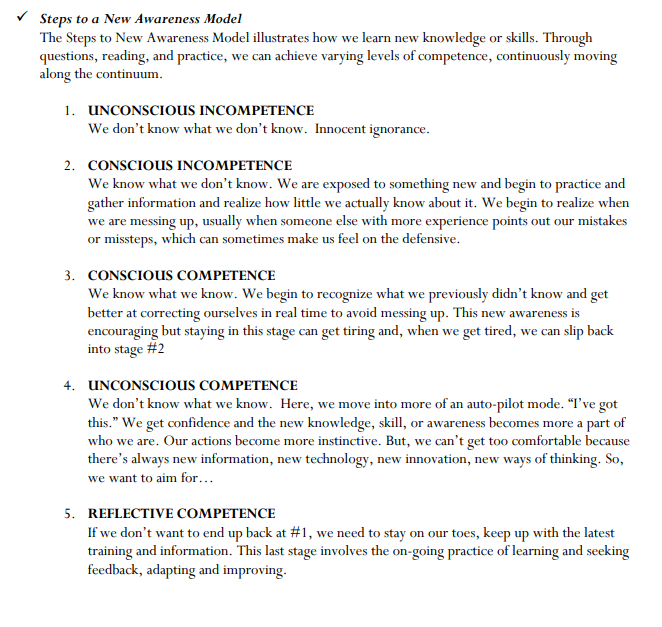
Stay Informed
